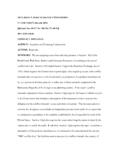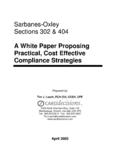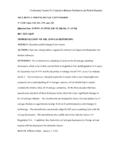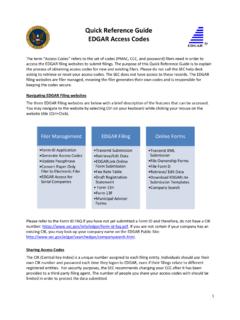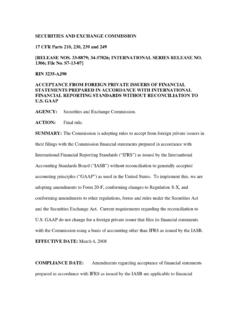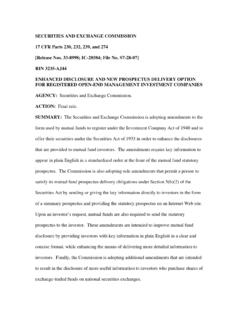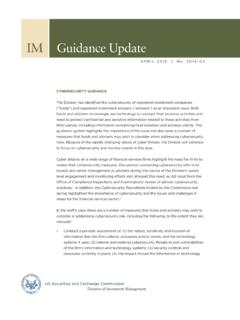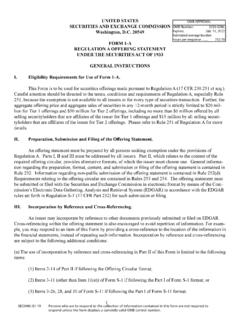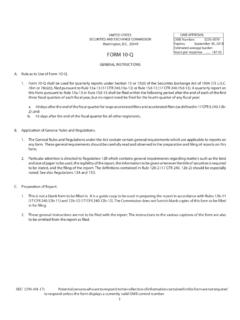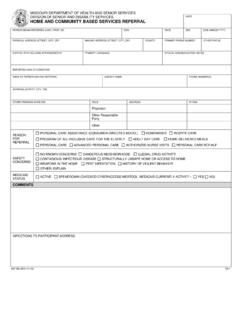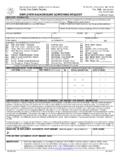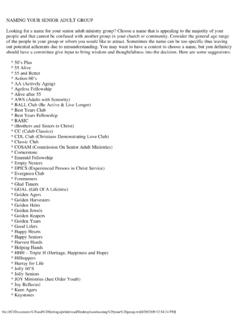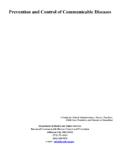Transcription of Protecting Senior Investors: Compliance, Supervisory and ...
1 Protecting Senior INVESTORS: COMPLIANCE, Supervisory AND OTHER PRACTICES USED BY FINANCIAL services FIRMS IN SERVING Senior INVESTORS Securities and Exchange Commission s Office of Compliance Inspections and Examinations,* North American Securities Administrators Association, and Financial Industry Regulatory Authority September 22, 2008 Statistics show that baby boomers today control more than $13 trillion in household investable assets, or over 50% of total household investment Projections also show that nearly one in every six Americans will be 65 or older by the year Given the increasing number of investors who will need advice and guidance, financial services firms are actively developing new products and seeking to provide financial advice and services to investors as they prepare for and reach retirement.
2 In light of these demographics, Staff at the Securities and Exchange Commission ( SEC ), the Financial Industry Regulatory Authority ( FINRA ) and the North American Securities Administrators Association ( NASAA ) view the protection of Senior investors as a top priority. While securities regulators have long focused on the Senior population and its particular vulnerability to fraud and abuse, beginning in 2006 securities regulators expanded collaborative efforts aimed at Protecting seniors by providing educational programs targeted to Senior investors, conducting focused examinations of financial services firms doing business with Senior investors, and prosecuting numerous investment scams preying on Senior Securities regulators have also provided information and guidance to financial services firms regarding Senior These efforts are part of our shared mission to protect Senior investors.
3 * This is a report of the Commission s Staff, FINRA and NASAA, and does not reflect the views of, or include findings or conclusions by the Securities and Exchange Commission. 1 Retirement of boomers will create market for advisers by Sue Asci, InvestmentNews, November 5, 2007. 2 Census projections as of August 2008, available at At year end 2007, approximately 38 million people were 65 or older. By 2020, they will number almost 55 million people. 3 On July 17, 2006, the SEC held its first Seniors Summit to examine how regulators and others could better coordinate efforts to protect older Americans from investment fraud. 4 See: Protecting Senior Investors: Report of Examinations of Securities Firms Providing 'Free Lunch' Sales Seminars (Joint Report of SEC Staff, NASAA, and FINRA, September 2007) ; Senior Investors: FINRA Reminds Firms of Their Obligations Relating to Senior Investors, (Regulatory Notice 07-43, September 10, 2007) ; and 1 As part of this ongoing effort, in February 2008, the SEC Staff, NASAA and FINRA undertook a new initiative to identify and publish examples of practices that financial services firms have developed with respect to their interactions with Senior investors.
4 To that end, we invited securities professionals, financial services firms, and industry groups to voluntarily share their practices with A cross-section of firms and financial services industry groups and others chose to participate in this effort, including broker-dealer and investment advisory firms, larger firms and smaller firms, and firms with a variety of organizational structures. We gratefully acknowledge their contributions and their commitment to work with us on this initiative. This Report summarizes practices used by financial services firms and securities professionals in serving Senior investors in the following areas: Getting started: how firms are thinking of ways to remodel their Supervisory and compliance structures to meet the changing needs of Senior investors; Communicating effectively with Senior investors; Training and educating firm employees on Senior -specific issues (such as how to identify signs of diminished capacity and elder abuse); Establishing an internal process for escalating issues and taking next steps; Encouraging investors of all ages to prepare for the future; Advertising and marketing to Senior investors; Obtaining information at account opening; Ensuring the appropriateness of investments.
5 And Conducting Senior -focused supervision, surveillance and compliance reviews. By sharing this information, we hope to provide practical examples to firms that are seeking to strengthen their infrastructure to assist them in working with Senior investors in an ethical, respectful and informed manner. This Report does not create or modify existing regulatory obligations with respect to Senior investors. It also does not catalog the full range of compliance practices applicable to Senior investors. Rather, this Report focuses on specific, concrete steps that firms are taking to identify and respond to issues that are common in working with Senior investors. By sharing this information, we also hope that financial services firms will continue to identify and implement additional practices to help ensure that the financial services industry continues to consider the particular needs of Senior investors.
6 I. The Challenges Any discussion about seniors raises the obvious question of who, exactly, is a Senior investor. Because investors of any age do not necessarily share the same characteristics, investment objectives, risk tolerances, or financial profiles, any definition of the term Senior investor NASAA s proposed model rule on the use of Senior -specific certifications and professional designations (April 1, 2008) 5 Notice of Solicitation of Public Views Regarding Practices Being Developed to Deal with the Increasing Number of Senior Investors (SEC Release No. 34-57308, February 11, 2008) 2would be either under-inclusive or over-inclusive.
7 Thus, we do not define Senior investor by reference to a specific age, but rather use the term to include investors who have retired or are nearing retirement. An investor s age and life stage are critical components of an investor s profile and firms cannot meet their regulatory obligations without considering these Nonetheless, issues such as diminished mental capacity may be more prevalent among older investors and older investors may also be more frequent targets for financial abuse. It is also important to note that not all firms are alike, and therefore practices that may make sense for one firm may not make sense for another. Our meetings with firms have demonstrated however, that there are certain issues and challenges that many firms commonly encounter in working with Senior investors.
8 Some of those issues relate to meeting regulatory obligations, such as assessing the appropriateness of an investment for investors at different stages of life, or marketing retirement products to investors who are at or near retirement age. Other challenges, such as recognizing the signs of diminished capacity or financial abuse, are not unique to the financial services industry. We have included in this Report examples of various steps that firms are taking to address these challenges because firms indicated to us that these issues are becoming increasingly common, and are of concern to the financial services industry. Ultimately, investors will benefit when financial services firms consider and address these challenges in a proactive way. The following scenario, along with others provided throughout this Report, illustrates some of the challenges that firms face when working with Senior investors and demonstrates the importance of taking steps to implement a program to address these issues.
9 Mr. Investor is a 76 year old widower. Bob Securities Professional has handled his investment portfolio for 25 years. His investment objective for the last 10 years has been to generate income. Recently, Mr. Investor told Bob Securities Professional that he wanted to generate higher returns from his account, and to change the beneficiaries on his IRA and Trust account from his children to his sister-in-law. Bob Securities Professional also began to notice that Mr. Investor didn t always return his telephone calls, which was unusual, as they spoke regularly over their 25 year relationship. Bob Securities Professional is concerned about altering the investment strategy to take on more risk and also about changing the beneficiary of Mr. Investor s account under these conditions.
10 Bob Securities Professional wonders what, if anything, he should do next. 6 Generally, life stage refers to the key milestones in an investor s life, such as marriage, buying a home, saving for children s college education, preparing for retirement and retirement. 3II. Practices Used by Financial services Firms In Serving Seniors During our meetings, many firms indicated that they have implemented and are implementing new processes and procedures aimed at addressing common issues associated with their interactions with Senior investors. Some firms have indicated that they sought to consider a full range of issues, such as how to communicate effectively with Senior investors; how to train and educate firm employees on Senior -specific issues; how to establish an internal process for escalating issues and taking next steps when issues or questions are identified; how to encourage investors of all ages to prepare for the future; how to advertise and market to Senior investors; obtaining information at account opening; how to ensure the appropriateness of investments; and how to conduct supervision, surveillance and compliance reviews focused on Senior -specific issues.

